Introduction
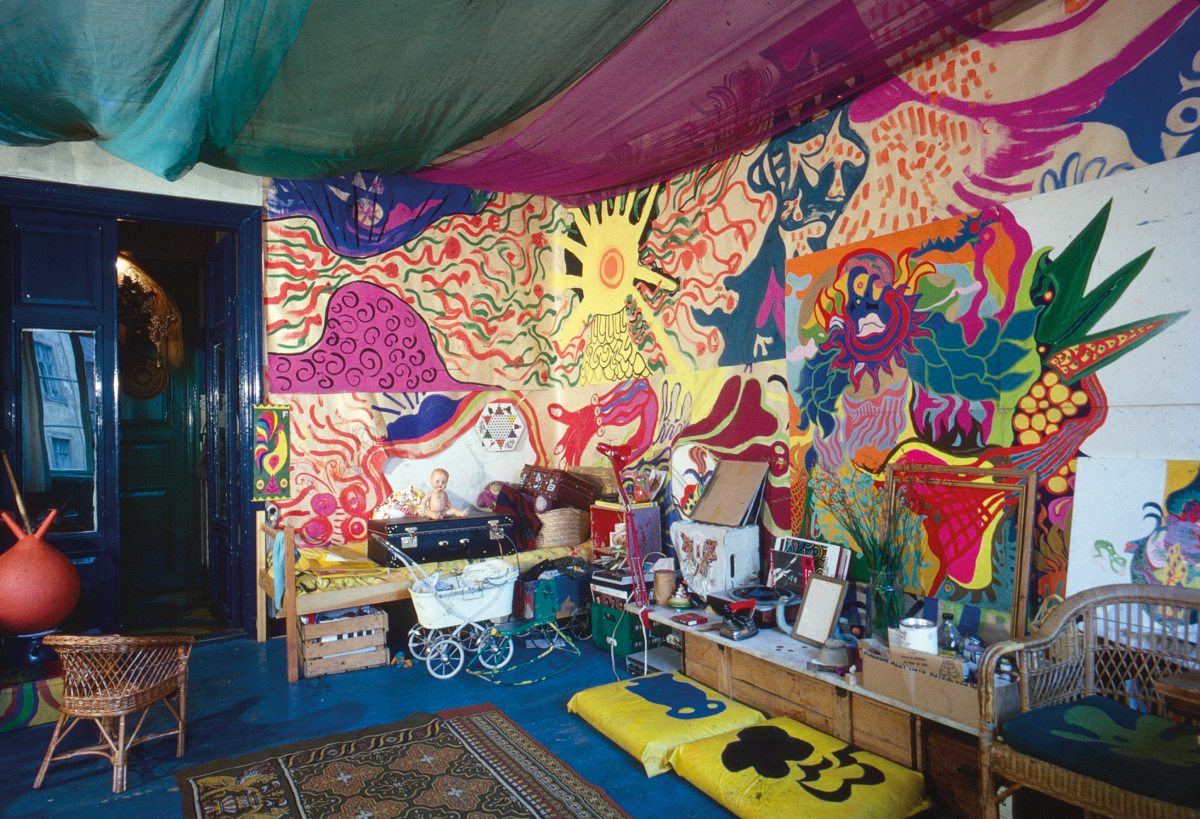
Here and Now is the first solo exhibition in a UK institution of Swedish artist, designer and educator Moki Cherry (1943 – 2009). Displaying over 30 artworks and archival material, it gives an insight into her expansive and collaborative practice across textile, sculpture, painting, drawing, writing, collage and video. The exhibition celebrates her exploration of where art and life meet, and her inventive resolve in the face of gendered challenges working both as an artist and a mother – issues which remain pertinent today.
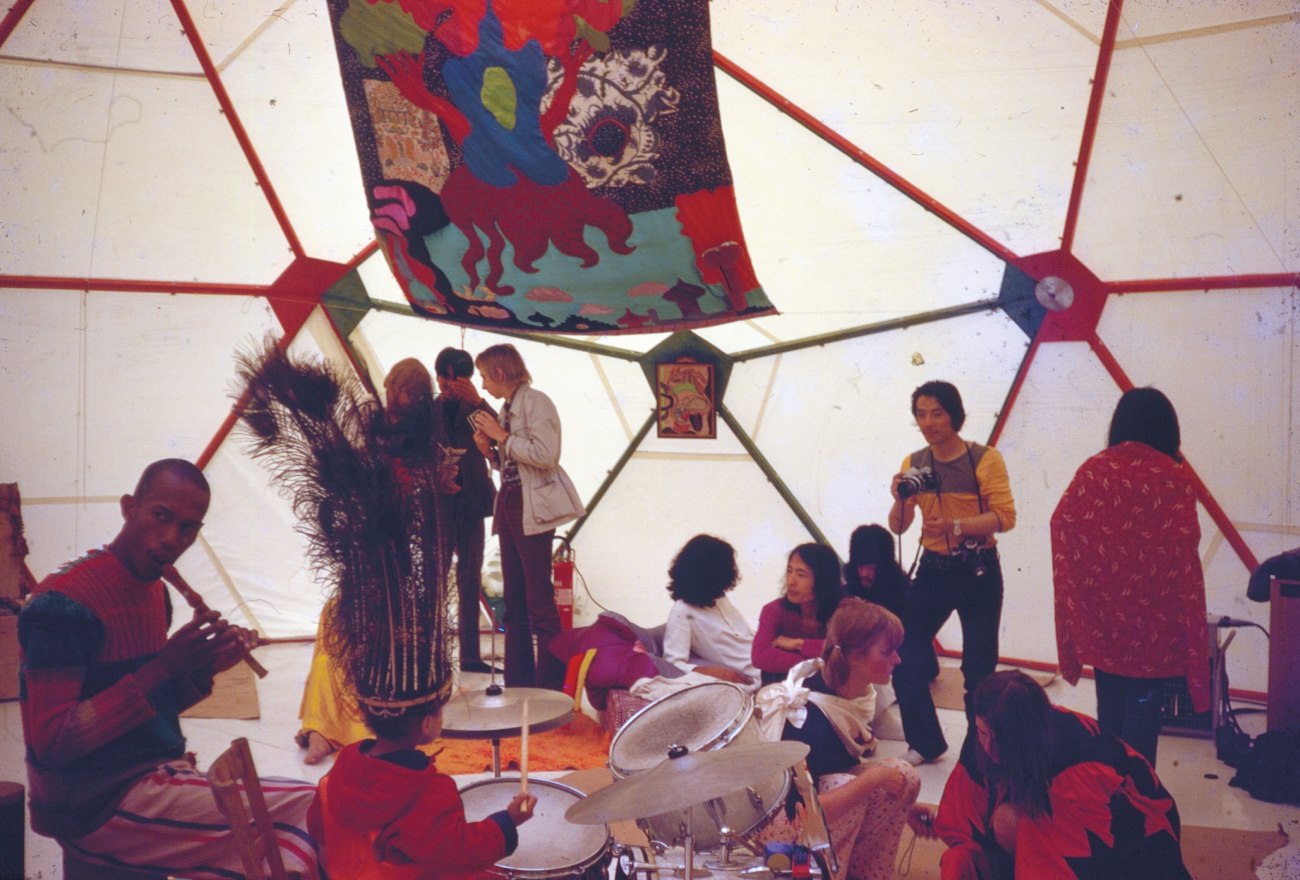
Trained as a fashion designer, Moki was already embedded in the Stockholm cultural scene when she met the jazz musician Don Cherry in 1963. It began their 20-year relationship and artistic collaboration which was formalised in 1967 as Movement Incorporated, later renamed Organic Music. A skilled pattern cutter, Moki created tapestries and costumes for their performances for which she is perhaps best known. Foregrounding Moki’s assertion of herself as an artist in her own right, the exhibition also features often overlooked aspects of her work such as a 16mm film she shot of her first solo exhibition in 1973 as well as sculpture, painting and writing which she practiced until her death in 2009.

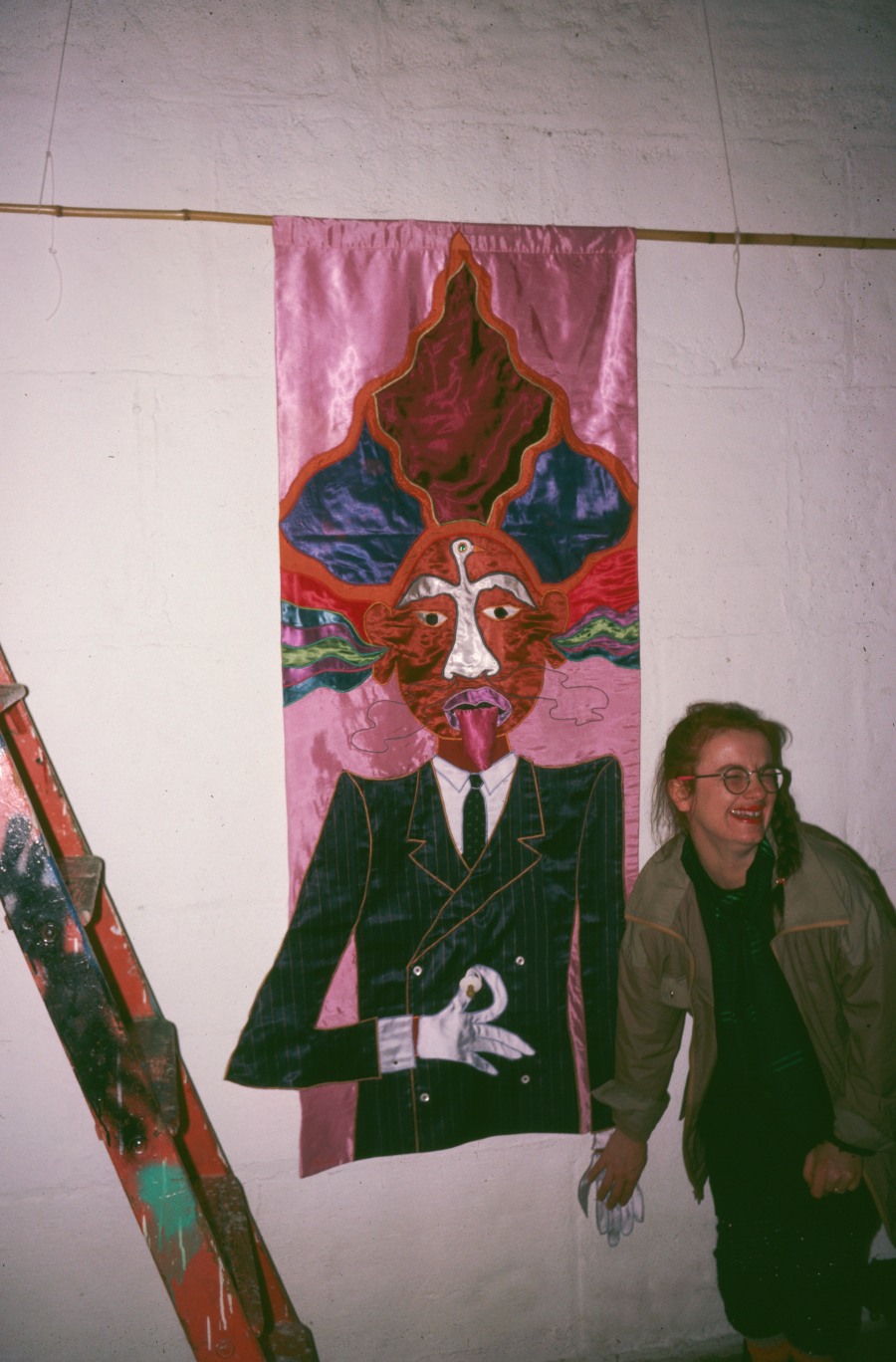
Throughout her life, Moki sought to use her creativity to communicate with and inspire others. The exhibition’s accompanying event programme will provide a platform for contemporary practitioners to respond to the significant themes in Moki’s work: from music, experimentation, collaboration, audience engagement and pedagogy, to working while raising a family as a mother.
Map & Captions
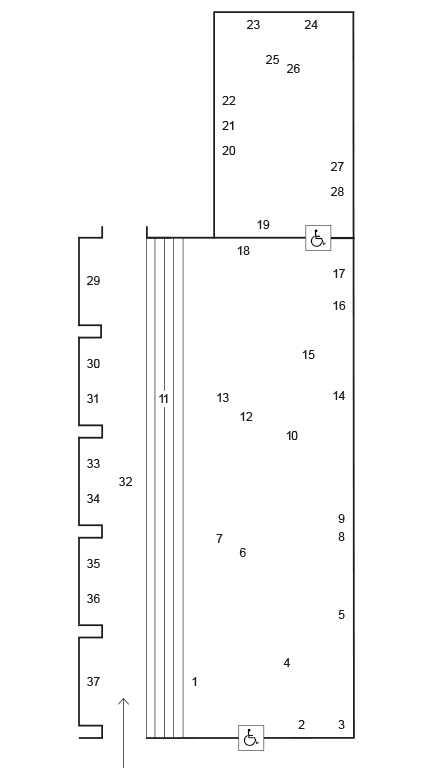
Captions
1. Title unknown (dragon), 1975, silk,
cotton, mixed fabrics.
2. Communicate, How?, 1970, acrylic on board.
3. Title unknown (door frame and back drop from Hear & Now), 1976, silk, cotton, mixed fabrics.
4. Organic Music, 1976, silk, cotton, mixed fabrics.
5. D. C (portrait of Don), 1981, silk, cotton, mixed fabrics.
6. Vitrine 1:
Title unknown (electrical appliances), c. 1990, Flashe paint on paper.
Notes from writing workshop (I was a human being until), c. 2004–2006, ink on paper.
Untitled (Tara, travel bag), c. 1974, mixed fabrics.
Moki and daughter Neneh at apartment in Gamla Stan, Stockholm, 1968, photograph. Photographer: Sven Åsberg.
Title unknown, date unknown, ink on paper.
Moki hanging Sun tapestry at Galleri 1, 1973, photograph. Photographer: Rita Knox.
Cherry family in clothes made by Moki, c. 1973, photograph.
Children’s costumes by Moki Cherry, c. 1964, magazine. Photographer: Lasse Stener.
Untitled, writing (Babies in universe), c. 1970, ink on paper.
Moki in doorway from Here & Now, 1977, Polaroid photograph.
7. Vitrine 2:
Untitled (Here & Now), date unknown, pencil on tracing paper.
Untitled (Hallo music), date unknown, acrylic on paper.
4. Organic Music, 1976, silk, cotton, mixed fabrics.
5. D. C (portrait of Don), 1981, silk, cotton, mixed fabrics.
6. Vitrine 1:
Title unknown (electrical appliances), c. 1990, Flashe paint on paper.
Notes from writing workshop (I was a human being until), c. 2004–2006, ink on paper.
Untitled (Tara, travel bag), c. 1974, mixed fabrics.
Moki and daughter Neneh at apartment in Gamla Stan, Stockholm, 1968, photograph. Photographer: Sven Åsberg.
Title unknown, date unknown, ink on paper.
Moki hanging Sun tapestry at Galleri 1, 1973, photograph. Photographer: Rita Knox.
Cherry family in clothes made by Moki, c. 1973, photograph.
Children’s costumes by Moki Cherry, c. 1964, magazine. Photographer: Lasse Stener.
Untitled, writing (Babies in universe), c. 1970, ink on paper.
Moki in doorway from Here & Now, 1977, Polaroid photograph.
7. Vitrine 2:
Untitled (Here & Now), date unknown, pencil on tracing paper.
Untitled (Hallo music), date unknown, acrylic on paper.
Don Cherry (painted box for audio 2-track tape reel), 1971, acrylic on cardboard box.
Octopuss Teater production at Moderna Museet (handmade programme), 1985, printed paper.
Octopuss Teater (pamphlet), c. 1983, ink on paper.
Christer Bothén and Moki Cherry, children’s workshop handout depicting instruments from around the world, c. 1973, photocopied paper.
Notes from writing workshop (I wish to make shows), c. 2004–2009, pencil on paper.
Untitled (Gongs and Solo), early 1970s, printed papers and ink on paper.
Utopias & Visions, Moderna Museet, Stockholm, 1971, photograph.
Note and illustration, 1970s, ink on paper.
Moki with whistle, c. 1973, photograph.
Untitled, writing (Who dares to make the commitment to living in the moment?), late 1970s or early 1980s, ink on paper.
Moki responded to the challenges of touring in a minivan with her young family and limited money by working creatively with textiles. While she initially worked in painting, she found that fabric was a practical solution to her transient lifestyle as she was able to roll it up and pack it in bags along with her sewing machine. She worked with fabrics from the places she travelled to and impressively sewed enormous compositions in small hotel rooms. Moki applied her signature style to tapestries that were displayed as stage environments and in galleries, as well as to bags and clothing.
8. Title unknown, 2009, acrylic on board.
9. Title unknown, 1998, acrylic on wood.
10. Swan, 1974, silk, cotton, mixed fabrics, plastic button.
11. Malkauns Raga, 1973, silk, cotton, mixed fabrics, assorted beads.
This tapestry spells out an Indian classical music scale in Latin alphabet alongside mudras, a Sanskrit term for symbolic hand gestures, which Moki and Don used as a teaching tool in workshops for children. In 1973 alone, they held 88 workshops and performances in schools. They were deeply committed to teaching and learning, moving to an old schoolhouse in Tågarp, Sweden in 1970, which was their home as well as a creative educational space for established artists and musicians and local children.
12. Vitrine 3:
Note (Give me that life), 1980s, pencil and ink on card.
Title unknown (I wish for a boa snake), 1985, acrylic and coloured pencil on paper.
Jag ger inte upp (I will not give up), 1970s, acrylic on board.
Notes from writing workshop (I am a visual artist in our society), c. 2004– 2006, ink on paper.
Title unknown (BODY PLEASURE), date unknown, coloured pencil on paper.
Love & Life, early 1990s, printed card. Title unknown (eye C myself, U C), 1971, ink on paper.
Unknown tapestry, c. 1981, photograph.
Untitled sketch (Who are you working for?), date unknown, ink on paper.
Moki sewing at Utopias & Visions, 1971, photograph.
Moki Cherry exhibition at Galleri 1, Stockholm, 1973. Photographer: Rita Knox.
Make an Offering to the Gods for Dayly Survival, c. 2004, oil pastel and pencil on paper.
While Moki exhibited her work in galleries and museums, she struggled to receive sustained recognition during her lifetime. She was often dismissed as a woman working in craft and iconography while minimalism was in vogue. With the added difficulties of raising a family while travelling frequently, Moki sought alternate ways to expand her creative practice; she never stopped making and experimenting with different forms and materials.
13. Vitrine 4:
Title unknown (woman with snake around neck), 1991, oil pastel on paper. Title unknown (animals and furniture), 1968, ink on paper.
Title unknown (creature birthing skull), date unknown, coloured pencil on paper. Title unknown, c. 1990, photograph. Portrait of Moki Cherry in Tågarp, 1982, photograph.
Title unknown (double-headed Chihuahua bowl), 1997, ceramic. Diary entry (I am in the question), 1968, notebook.
Plans for ceramics, c. 1992–1997, sketchbook.
Title unknown (hanging masks and shoes), 1990s, coloured pencil on paper.
Moki Galleri Händer poster in street, Stockholm, 1991, photograph.
Title unknown (Mexico), 1977, acrylic on canvas.
14. Title unknown (sun), 1973, silk, cotton, mixed fabrics.
15. Title unknown (fabric sculpture from Utopias & Visions), 1971, silk, satin, polystyrene balls.
Moki created this sculpture for the exhibition Utopias and Visions 1871– 1981 at Moderna Museet Stockholm in 1971. She and Don ran daily workshops and happenings in a geodesic dome in the exhibition while living at the museum with their children. This experimental living artwork dissolved boundaries between art and life, the public and private, and artists and audiences.
16. Breakfast at Tiffany’s, 1979, silk, cotton, cord, metal objects, glass buttons.
17. Title unknown (woman with doll), 1981, silk, cotton, mixed fabrics, plastic doll.
18. Airmail, 1980, silk.
19. Spirit, 1976, silk, cotton, mixed fabrics, plastic buttons.
20. Not My Cup of Tea, 2006, printed papers on board.
Moki worked with collage from the late 1990s through to the 2000s, covering furniture with printed matter and making individual photomontages. She explained: ‘I find it a good vehicle to reflect the situation we are currently living and existing in .... It is a very interesting expedition, finding the images. Coming from all sources, sometimes spreading fifty, sixty, seventy years in one collage and bringing it to a feeling of nowness and concern is very exciting, like a ball that started rolling in ancient times that connects everything.’
21. Buddha, 1998, acrylic on wood, mirror, electric lights.
From the 1980s Moki developed work in sculpture, ceramics and collage. Working as a set designer for the Apollo Theatre, Harlem in the 1990s, Moki used power tools and incorporated electric lights in wood sculptures in her art. This piece reflects Moki’s deep-rooted influences of Buddhist teachings and philosophies. She studied Tibetan Buddhism for a large part of the 1970s and applied it to her everyday life and artistic practice.
Octopuss Teater production at Moderna Museet (handmade programme), 1985, printed paper.
Octopuss Teater (pamphlet), c. 1983, ink on paper.
Christer Bothén and Moki Cherry, children’s workshop handout depicting instruments from around the world, c. 1973, photocopied paper.
Notes from writing workshop (I wish to make shows), c. 2004–2009, pencil on paper.
Untitled (Gongs and Solo), early 1970s, printed papers and ink on paper.
Utopias & Visions, Moderna Museet, Stockholm, 1971, photograph.
Note and illustration, 1970s, ink on paper.
Moki with whistle, c. 1973, photograph.
Untitled, writing (Who dares to make the commitment to living in the moment?), late 1970s or early 1980s, ink on paper.
Moki responded to the challenges of touring in a minivan with her young family and limited money by working creatively with textiles. While she initially worked in painting, she found that fabric was a practical solution to her transient lifestyle as she was able to roll it up and pack it in bags along with her sewing machine. She worked with fabrics from the places she travelled to and impressively sewed enormous compositions in small hotel rooms. Moki applied her signature style to tapestries that were displayed as stage environments and in galleries, as well as to bags and clothing.
8. Title unknown, 2009, acrylic on board.
9. Title unknown, 1998, acrylic on wood.
10. Swan, 1974, silk, cotton, mixed fabrics, plastic button.
11. Malkauns Raga, 1973, silk, cotton, mixed fabrics, assorted beads.
This tapestry spells out an Indian classical music scale in Latin alphabet alongside mudras, a Sanskrit term for symbolic hand gestures, which Moki and Don used as a teaching tool in workshops for children. In 1973 alone, they held 88 workshops and performances in schools. They were deeply committed to teaching and learning, moving to an old schoolhouse in Tågarp, Sweden in 1970, which was their home as well as a creative educational space for established artists and musicians and local children.
12. Vitrine 3:
Note (Give me that life), 1980s, pencil and ink on card.
Title unknown (I wish for a boa snake), 1985, acrylic and coloured pencil on paper.
Jag ger inte upp (I will not give up), 1970s, acrylic on board.
Notes from writing workshop (I am a visual artist in our society), c. 2004– 2006, ink on paper.
Title unknown (BODY PLEASURE), date unknown, coloured pencil on paper.
Love & Life, early 1990s, printed card. Title unknown (eye C myself, U C), 1971, ink on paper.
Unknown tapestry, c. 1981, photograph.
Untitled sketch (Who are you working for?), date unknown, ink on paper.
Moki sewing at Utopias & Visions, 1971, photograph.
Moki Cherry exhibition at Galleri 1, Stockholm, 1973. Photographer: Rita Knox.
Make an Offering to the Gods for Dayly Survival, c. 2004, oil pastel and pencil on paper.
While Moki exhibited her work in galleries and museums, she struggled to receive sustained recognition during her lifetime. She was often dismissed as a woman working in craft and iconography while minimalism was in vogue. With the added difficulties of raising a family while travelling frequently, Moki sought alternate ways to expand her creative practice; she never stopped making and experimenting with different forms and materials.
13. Vitrine 4:
Title unknown (woman with snake around neck), 1991, oil pastel on paper. Title unknown (animals and furniture), 1968, ink on paper.
Title unknown (creature birthing skull), date unknown, coloured pencil on paper. Title unknown, c. 1990, photograph. Portrait of Moki Cherry in Tågarp, 1982, photograph.
Title unknown (double-headed Chihuahua bowl), 1997, ceramic. Diary entry (I am in the question), 1968, notebook.
Plans for ceramics, c. 1992–1997, sketchbook.
Title unknown (hanging masks and shoes), 1990s, coloured pencil on paper.
Moki Galleri Händer poster in street, Stockholm, 1991, photograph.
Title unknown (Mexico), 1977, acrylic on canvas.
14. Title unknown (sun), 1973, silk, cotton, mixed fabrics.
15. Title unknown (fabric sculpture from Utopias & Visions), 1971, silk, satin, polystyrene balls.
Moki created this sculpture for the exhibition Utopias and Visions 1871– 1981 at Moderna Museet Stockholm in 1971. She and Don ran daily workshops and happenings in a geodesic dome in the exhibition while living at the museum with their children. This experimental living artwork dissolved boundaries between art and life, the public and private, and artists and audiences.
16. Breakfast at Tiffany’s, 1979, silk, cotton, cord, metal objects, glass buttons.
17. Title unknown (woman with doll), 1981, silk, cotton, mixed fabrics, plastic doll.
18. Airmail, 1980, silk.
19. Spirit, 1976, silk, cotton, mixed fabrics, plastic buttons.
20. Not My Cup of Tea, 2006, printed papers on board.
Moki worked with collage from the late 1990s through to the 2000s, covering furniture with printed matter and making individual photomontages. She explained: ‘I find it a good vehicle to reflect the situation we are currently living and existing in .... It is a very interesting expedition, finding the images. Coming from all sources, sometimes spreading fifty, sixty, seventy years in one collage and bringing it to a feeling of nowness and concern is very exciting, like a ball that started rolling in ancient times that connects everything.’
21. Buddha, 1998, acrylic on wood, mirror, electric lights.
From the 1980s Moki developed work in sculpture, ceramics and collage. Working as a set designer for the Apollo Theatre, Harlem in the 1990s, Moki used power tools and incorporated electric lights in wood sculptures in her art. This piece reflects Moki’s deep-rooted influences of Buddhist teachings and philosophies. She studied Tibetan Buddhism for a large part of the 1970s and applied it to her everyday life and artistic practice.
Biography
Moki Cherry (1943 – 2009) was a Swedish interdisciplinary artist and designer who worked in tapestry, fashion design, painting, music, collage, woodwork and ceramics. She worked with materials that have a relationship to functionality and themes relating to nature and spirituality. Moki envisioned her life and work as part of an aesthetic utopian vision of ‘home as stage, stage as home’, in which her artworks were experienced in the home, in music and theatre performances, and in art galleries.
Recent solo exhibitions include Moki Cherry, Galleri Nicolai Wallner (2022), Copenhagen, Denmark; Organic Music Societies, Argos, Brussels, Belgium (2022); Moki Cherry: Communicate, How? Paintings and Tapestries, 1967 – 1980, Corbett vs. Dempsey, Chicago, USA (2021); and Organic Music Societies, Blank Forms, New York City, USA (2021). Her works are held in the collections of the Centre Pompidou, Paris, France; Collezione Maramotti, Reggio Emilia, Italy; Malmö Konstmuseum, Malmö, Sweden; Moderna Museet, Stockholm, Sweden; and Muzeum Susch, Zernez, Switzerland.
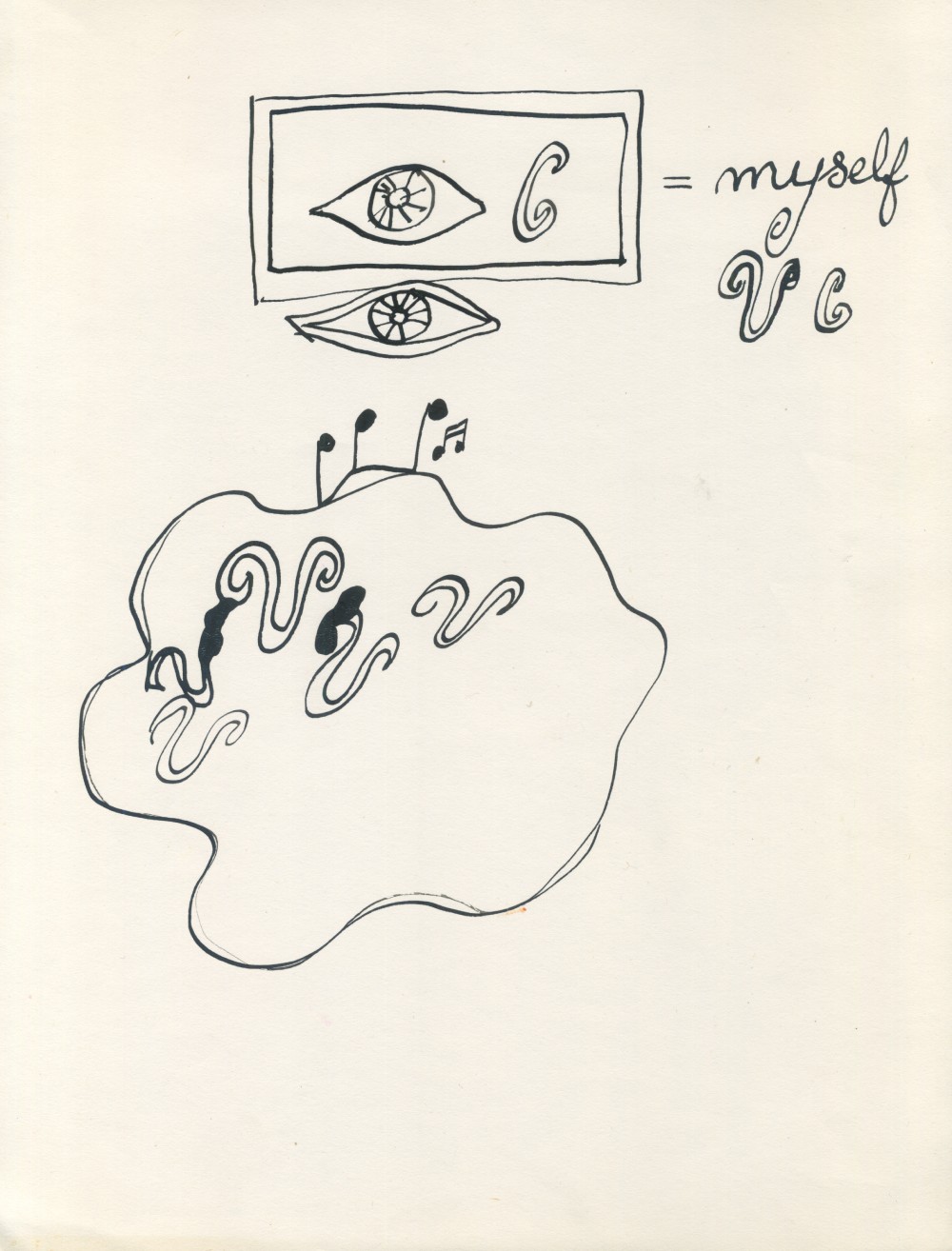


Moki Cherry, detail from Huvudbladet, ‘Green’ Issue, June 1971, centrefold, print on paper. Courtesy of the Cherry Archive, Estate of Moki Cherry.

Moki Cherry, detail from Huvudbladet, ‘Green’ Issue, June 1971, centrefold, print on paper. Courtesy of the Cherry Archive, Estate of Moki Cherry.










no. 236848.